Introduction
Humans have been aware of and fascinated by the patterns on their fingers for thousands of years, although there is no conclusive evidence of the first time that the unique nature of these impressions was understood. Children today who finger paint exercise a similar curiosity about the strange and beautiful patterns of lines they have created. The evolution of fingerprint classification and identification as a science has supplied not only comprehensive knowledge of what fingerprints are and how they are formed, but also their full potential as a forensic tool.
History
The following timeline illustrates the progression from fascination to friction skin classification and identification as it is practiced today.
• 1955-1913 BCE: Finger seals on contracts are attributed to the reign of Hammurabi in Babylon.
• Second or third century BCE: Clay seals bearing fingerprints are used by the Chinese.
• Twelfth century: A Chinese novelist makes reference to the use of fingerprints in criminal identification.
• 1684: In England, Nehemiah Grew described the pores and their functions in the skin of the hands and feet.
• 1686: Marcello Malpighi, an Italian university professor, conducted the first friction ridge research under the newly invented microscope.
• 1788: An unsubstantiated report that a German doctor, J.C.A. Mayer, stated his belief in the unique nature of fingerprints.
• 1823: Johannes Purkinje, a German professor, classified the patterns of the finger impressions but ascribed no identification value to them.
• 1860s: In India, Sir William Herschel initiated the taking of fingerprints in efforts to control fraud in pension payments. He also established the immutability of ridge detail by taking his own fingerprints over a long period of time.
• 1880: Dr Henry Faulds concluded that the ridge detail of the fingers was unique. He further claimed to have established identity through comparison of latent fingerprints to known samples.
• 1892: Sir Francis Galton published Fingerprints,a topic in which he supported Herschel’s findings regarding the unchanging, and hence reliable, nature of ridge detail.
• 1891: Juan Vucetich developed and implemented a workable fingerprint identification system in Argentina.
• 1892: In Argentina, the first murder case in the world to be solved by fingerprints.
• 1896: Argentina initiated the first criminal record registry based on fingerprints.
• 1896: Sir Edward Henry created the Henry system of ten print classification, which has persisted as the ten print classification system of choice into the middle of the twentieth century, until the advent of computerized filing systems.
• 1901: First Henry Fingerprint Classification System at Scotland Yard.
• 1912: Edmond Locard, Lyons, France, credited with poroscopy, the science of identification through the position and structure of pores.
• 1930s: Single Fingerprint System developed by Battley, New Scotland Yard
Anatomy
Dactyloscopy (from the Greek word for finger) is the study of fingerprints. Specialized ridged skin, called friction skin, is found exclusively on the palmar surfaces of the hands and the plantar (sole) surfaces of the feet. These are referred to collectively as volar surfaces. Friction skin is designed for grasping and holding objects. All primates have friction skin on the palmar and plantar surfaces.
Ridgeology, a term which has recently entered the lexicon, is more comprehensive in the description of friction skin science because it is not restricted to the tips of the fingers. Although finger and palm prints are the focus of this article, all information concerning identification applies equally to the friction skin of the feet. Friction skin differs significantly in structure and function from the skin covering the rest of the body as follows.
1. It is hairless.
2. It contains no sebaceous (oil) glands.
3. It has a much higher concentration of nerve endings.
4. It has a much higher concentration of sweat glands.
5. There is a lack of pigmentation.
Structure of Friction Skin (Fig. 1)
Epidermis This is the outer layer of tough ridged skin bearing only sweat pores; no vessels, nerve endings or sweat glands. It functions as an aid in gripping and as a protective cover for the delicate components of the dermis.
Dermis This contains the sweat glands, nerve endings and the papillary layer which determines the unique fingerprint code.
Papillae These are pegs or protuberances, arranged in twinned rows on the surface of the dermis. Each double row of papillae on the dermis is represented by one ridge on the epidermis.
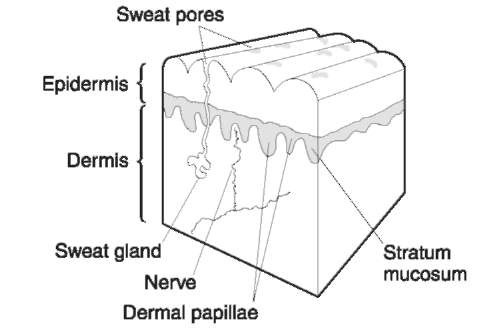
Figure 1 Structure off riction skin.
Stratum mucosum This is the lower level of the epidermis in contact with the papillary layer.
Eccrine glands More commonly referred to as the sweat glands, the eccrine glands excrete perspiration, thus accomplishing two principal objectives: expulsion of waste material through the pores; temperature regulation, through the cooling effect of perspiration. On the friction skin of the hands an additional purpose is served. The resulting moisture on the friction ridges renders the fingers more efficient in gripping, manipulating and separating objects. Licking one’s finger to turn a page utilizes the same principle. Although approximately 99% of the excretion is water, the remainder is composed of various organic salts, nitrogenous compounds and amino acids. These ingredients are vital to the process of detecting fingerprints. When the friction skin of the hands comes in contact with an object, some of the material present on the skin is transferred, placing an invisible image of the detail on that surface, in the manner of a stamp pad. This analogy is even more appropriate if visible material such as ink, paint or dirt is transferred from the fingers. In fact, the taking of fingerprints with ink and paper is merely the controlled and optimized application of actions we take every day when we inadvertently leave our fingerprints on objects we touch. The amount and composition of finger deposit varies greatly as a result of personal metabolism, climate, diet and mood. It is therefore not surprising that some people are more reliable donors than others.
Classification
Elements of a fingerprint (Fig. 2)
• Recurve: A recurve is any ridge retracing its course, and includes the bend in a loopor the circular course of a whorl. Arches and tented arches lack free recurves.
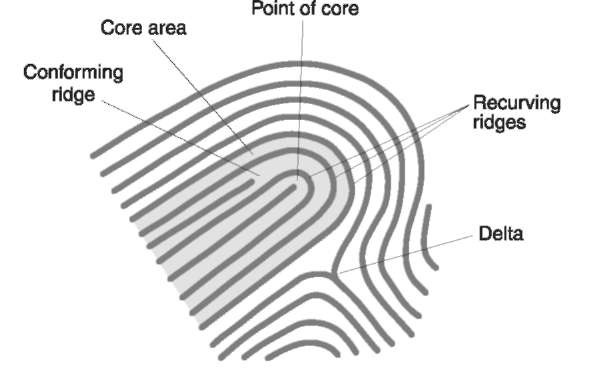
Figure 2 Elements of a fingerprint.
• Delta: When ridges converge on a point from three directions, the point is referred to as a triradius or delta. Arches and some tented arches lack deltas.
• Core: The central area of the pattern is referred to as the core and contains the point of core, all of the recurving ridges and the ridges which conform to them. The precise point of core is determined differently for each pattern type.
Fingerprint patterns
There are eight fingerprint pattern types.
• Arch: Ridges lying one above the other in an arching configuration. Arches lack both recurves and deltas (Fig. 3A).
• Tented arch: Arching formation with at least one upthrusting ridge at right angles to ridges above it (Fig. 3B).
• Ulnar/radial loop: Contains at least one free recurving ridge and one delta. In ulnar loops, recurving ridges originate from and return to the little finger side of the hand, named after the ulna forearm bone. In radial loops, recurving ridges originate from and return to the thumb side of the hand, named after the radius forearm bone (Fig. 3C).
• Whorl: Contains at least one free recurving ridge and two points of delta. A straight line between the points of delta will cut across at least one of the ridges revolving around the core (Fig. 3D).
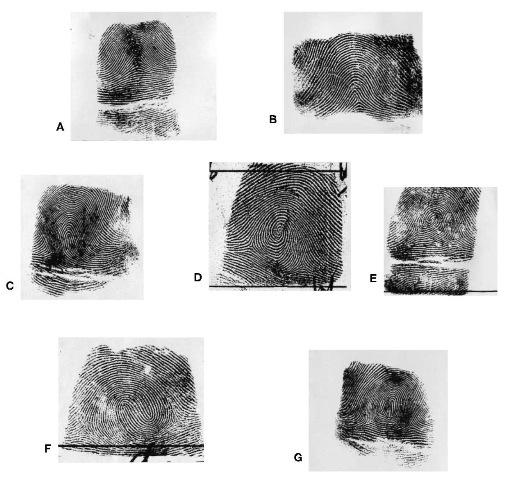
Figure 3 Fingerprint patterns. A, Arch; B, tented arch; C, ulnar/radial loop; D, whorl; E, central pocket loop; F, double loop; G, composite.
• Central pocket loop: Contains at least one free recurving ridge and two points of delta. None of the ridges revolving around the core will be intersected by a straight line between the points of delta (Fig. 3E).
• Double loop: Contains two separate loop formations and two points of delta (Fig. 3F).
• Composite: Contains at least two different patterns, other than the basic arch (Fig. 3G).
• Accidental: Contains two deltas, one relating to an upthrust and the other relating to a recurve. Unlike the composite, the two pattern components in the accidental are amalgamated. In fingerprint pattern classification, no distinction is made between composite and accidental.
Loops, whorls, arches, indeed any variation from parallel ridges, may be found on any area of friction skin.
Ten print classification
In order to appreciate the value of classification, one might imagine a large reference library in which all the topics are filed by the last name of the author. Anyone wishing to locate a topic by subject alone would be faced with an impossible task. Library filing systems, however, enable one to find a topic quickly, without knowing the author’s name. Similarly, using the Henry Classification System, a ‘John Doe’ set of fingerprints could be searched and located in the file. Positive identification of criminals, with or without reliable names, had entered a new era.
In the Henry System, sets of fingerprints were given a primary classification, based on the distribution of patterns in the fingers. There are 1024 possible primary segments in the database, and further extensions were achieved by assessing the specific features of each digit. In order to conduct a search, subject fingerprints were classified in exactly the same manner as those in the database. Only the segment bearing the same classification required individual comparison to determine identity.
Single fingerprint classification
The Henry System allowed for the filing and searching of entire sets of fingerprints but was not useful in the search of individual ‘cold’ crime scene impressions. The Battley System was developed to address this need. At time of arrest, an extra set of fingerprints was taken on a serrated form. Each digit was classified, first by pattern type, and then by other extensions. The individual digits were then separated and filed. A crime scene impression was examined to determine the most probable digit(s), classified and searched. Several factors, however, have limited the speed and accuracy of the manual classification systems, as the databases grew in size.
1. Ulnar loops and whorls occur far more frequently than the other pattern types. Ten print classifications composed of these common patterns resulted in common classifications, and therefore comprised a large part of the collection.
2. As the size of a collection became more cumbersome, searches became more time consuming.
3. Many impressions do not fall exclusively into one of the pattern types. Depending on the amount of ink and pressure exerted during recording, an ulnar loopmay resemble a tented arch or even a central pocket loop. It became necessary to ‘reference’ such impressions for a possible alternative pattern type, which often changed the primary classification.
4. Manual classification is also affected by individual interpretation. The technician making the search may not arrive at the same conclusions as the person(s) who classified the database.
The difference between fingerprint classification and identification must be clearly understood. Classification of fingerprints allows large segments of the database to be eliminated prior to the comparison process. It places a small number of possible matches in front of a technician for the final determination of identity or nonidentity. Regardless of the classification and search methods used, however, final comparison and identification is achieved by a fingerprint specialist.
For decades, manual fingerprint systems, including the Henry and Battley systems, provided a vital search tool in the identification of criminals from large fingerprint collections. They have been superseded, however, by automated techniques which excel in both speed and accuracy.
Identification Philosophy
Fingerprint identification is based on two scientific axioms.
First, fingerprint detail is immutable. The relationship of ridge characteristics does not change from before birth until after death, except in size as a child reaches adulthood, and through injury, disease and decomposition. There is no arbitrary appearance or disappearance of the minutiae during life, and due to the thick, tough nature of friction skin, it is often the last of the soft tissue to decompose after death.
Second, there are no duplications within Nature. Every area of friction skin is unique to that individual on which it appears, to the exclusion of all others, living or dead. This position is, of course, unprovable in the conventional sense. No one has ever, or will ever have the capability to examine the entire friction skin of every human being who has ever lived. However, the overwhelming weight of precedent is on the side of this premise. Fingerprints have been in use for identification purposes for approximately 100 years. In that time no area of friction skin from one individual has ever been found to be identical to any other area, recorded either from the same individual or another.
The individuality of natural things is not limited to fingerprints. Some examples are more noticeable, including the stripe pattern on zebras and the striations on conch shells. Forensic studies have included the use of lip prints, ear prints, flexion creases and muzzle prints of cattle.
Identical twins
The most similar beings on earth are monozygotic (one egg) twins. They are the result of a single fertilized egg which subsequently divides to form two separate beings. The interval between fertilization and division can vary considerably. A zygote remaining as one entity for a longer period of time will undergo more common development before division, and the resulting twins will be even more alike. They are referred to as ‘mirror image’ twins. If the zygote divides after too much development has occurred, an incomplete separation (Siamese twins) will result. Fingerprints are formed randomly during the fourth fetal month, long after separation has occurred.
Current DNA technology is unable to differentiate between identical twins. Fingerprint patterns of identical twins may be strikingly similar, but the configuration and sequence of minutiae are as individual and unique as those of any two unrelated beings. It is significant that identical twins routinely do not share even the same patterns on their fingers. Fig. 4 reveals the similarities and differences between identical triplets, the result of an egg dividing, followed by one of the twins dividing again.
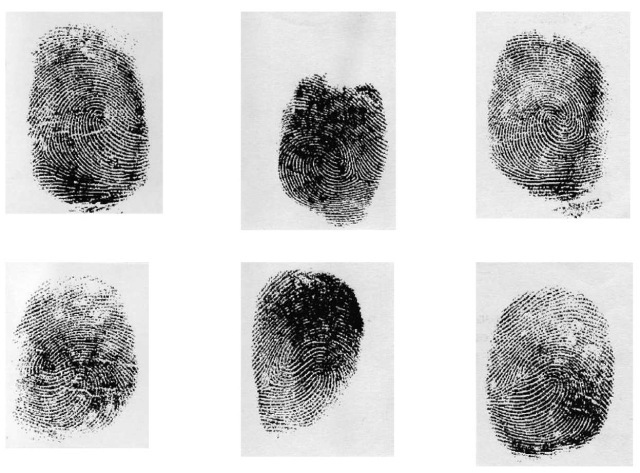
Figure 4 Thumbprints of identical triplets.
Scars
Damage to the friction skin can be characterized as temporary or permanent. In the case of a minor injury such as a blister or paper cut, only the epidermis will be affected, and it will heal without scarring. If the injury extends to and includes the dermal layer where the fingerprint pattern resides, a permanent disruption in the fingerprint will result. At the conclusion of the healing process, this disruption or scar will be as permanent as the minutia configuration itself, and subject only to the same variations in appearance. As such, scars constitute a valuable addition to the identification process. The two fingerprints in Fig. 5, which were recorded 22 years apart, illustrate the persistency of permanent scars.
The comparison process
Fingerprint ridges routinely come to an end between two other ridges, or split into two (bifurcation). These disruptions are referred to as ridge characteristics, or minutiae, and occur on all friction skin (Fig. 6). There exists no common agreement as to the number and terminology of minutiae. Although many composites occur, there are only three basic types of minutiae; ridge endings, bifurcations and ridge dots. All other minutiae are combinations of these basic types. There are considerable differences in the rarity of minutiae, however, and commensurate weight must be given to this factor in the comparison process.
A trained expert concludes that two fingerprints have the same origin when he/she is satisfied that the sequence of minutiae is in continuous agreement and identical sequence. If the axiom regarding the individuality of ridge detail is accepted, it is not logical to accept that two impressions from different sources can have any true agreement of characteristics. The inability to distinguish between two impressions due to lack of sufficient and clear recording, however, is not only logical but routinely encountered. Also, no two impressions, whether they be latent, inked or any combination of these, will contain the same, or the same number of ridge characteristics. In the majority of cases, more characteristics will be present in an inked recording, although the reverse occasionally occurs. A comparison is therefore based on the characteristics common to both (Fig. 7).
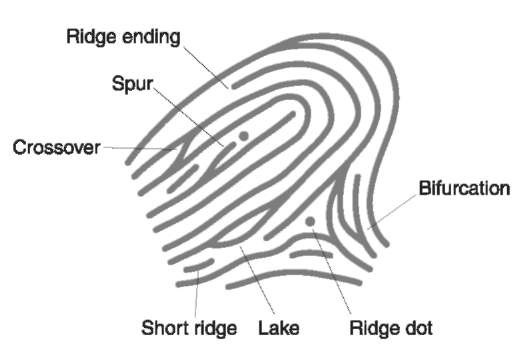
Figure 6 Ridge characteristics.
Poroscopy
The placement, frequency and configuration of the pores on the friction ridges is unique and potentially equal in identification value to the ridge endings (Fig. 8). Due to their small size, however, their appearance in a fingerprint depends on the sensitivity of the recording technique, and they currently play a limited role in the determination of identity.
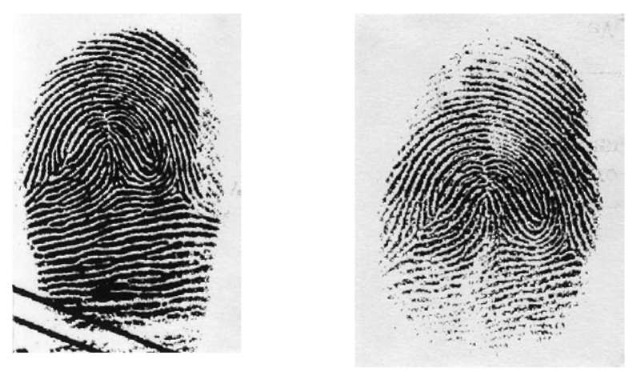
Figure 5 Scarred fingers recorded 22 years apart.
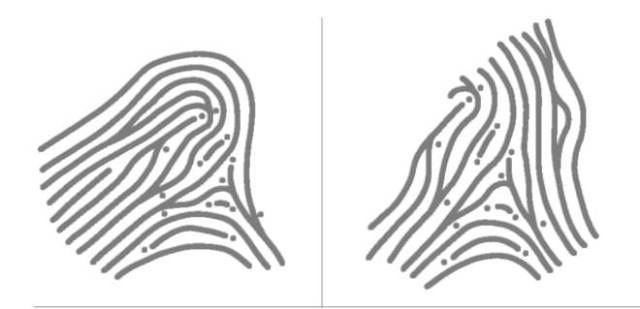
Figure 7 Agreement of ridge detail in sequence.
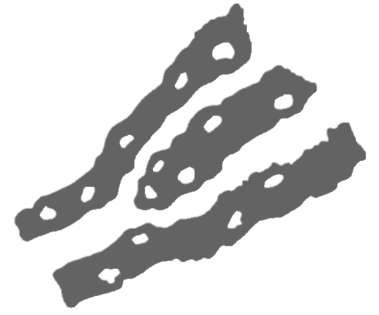
Figure 8 Sweat pores as they appear on ridges.
Size
Size relationships can play no part in determining fingerprint identity, except that ridge characteristics in two impressions from the same finger, will appear in the same general areas. The friction skin and the soft tissue behind it are flexible in nature. Inking, pressure and twisting, which cause distortion, are minimized when the print is professionally recorded. They vary greatly, however, in the everyday acts of lifting, pushing, grasping and sorting. Overlay techniques are therefore impractical in determining or displaying identity.
What do you see?
The comparison of fingerprints is obviously a visual exercise, but it involves much more than seeing. For example, a native Californian and a Bushman standing at a busy intersection in Los Angeles, will receive the same visual information but the manner and result of the information processing will vary greatly. Similarly, if the same two individuals are viewing an animal track in the Kalihari Desert, there will be a radical difference in information processing, although they both ‘see’ the same thing. In each case, only one observer possesses the skill and knowledge base to process the visual information successfully. This point must be clearly established as a prerequisite to understanding of fingerprint identification.
The attributes absolutely essential for the comparison and identification of fingerprints include:
1. A highly developed aptitude for recognition of spatial relationships;
2. Comprehensive knowledge of the anatomy, physiology and appearance of friction skin and recordings;
3. Extensive experience in examining and comparing a high volume of fingerprints.
Identification protocol
Determination of fingerprint identity requires adherence to a comparison protocol.
• The unknown impression is examined, and all minutiae are analyzed.
• The unknown impression is then compared to the known, to determine if a relationshipexists.
• Weight is assigned in a comparison, not only to the number of minutiae in agreement, but also the rarity and clarity of those characteristics. Differences in appearance, due to recording technique, pressure and other factors, must be anticipated.
• If all characteristics common to both impressions are in agreement in identical sequence, with differences only in appearance, the only reasonable conclusion to be reached is that they were made by the same finger.
The issue of minimum number of points required for an identification has been continuously revisited by fingerprint specialists. It is generally agreed by all professional organizations that no set number of characteristics can be required for a conclusion of identity. This is a different issue entirely from jurisdictional policies which vary from country to country. Professional policy requires the independent comparison and endorsement in writing by a peer of the identification before positive findings are released.
Findings
Most fingerprint specialists believe strongly that only three opinions regarding the identity of the fingerprint should be volunteered.
1. Positive certainty: the fingerprint was made by the person indicated to the exclusion of every other person, living or dead.
2. Negative certainty: the fingerprint was not made by the person indicated.
3. Inconclusive: the impression lacks sufficient clear detail upon which to make a conclusion of either identity or elimination.
An opinion of possibility or probability is often solicited in court and must be addressed, but volunteering such opinions, or failing to qualify them by saying that the fingerprint could have been made by someone else, is generally viewed by the majority of professionals to be inappropriate.
There are a wide range of additional and valuable conclusions, however, which can be and should be drawn from the examination and comparison of fingerprints. These conclusions exploit the full expertise of the examiner and can extend far beyond the presence or absence, and the identity or nonidentity of a fingerprint. It is the responsibility of the technician that the maximum amount of probative information be extracted from the findings and relayed, either in the context of investigative leads or courtroom testimony.
These include, but are not limited to the following.
Location The exact location of a fingerprint on an exhibit or within a crime scene may determine its value to the investigation. For example, fingerprint evidence located at a robbery scene will be more significant if it is noted to be from an area not accessible to the public, or to refine it even further, not accessible to anyone but the owner.
Position The position and direction of a fingerprint identification may offer clues to the activity of the donor which may eliminate alternative explanations. An impression which ends abruptly along a fold line on a piece of paper can place that impression at a moment in time, and associate the person with a specific activity.
Similar fact The print of an accused trafficker repeated in the same position on many drug containers carries a more serious implication than simple possession of narcotics.
Absence of fingerprints
Another conclusion which is frequently reached in error by lay persons is that absence of a person’s fingerprints on an object eliminates that person from having touched the object. If this were so, all of the following statements would be true.
1. Everyone always leaves identifiable fingerprints each time they touch something.
2. All surfaces are capable of receiving and retaining these prints, and are amenable to fingerprint examination.
3. Everyone’s finger deposit always contains a sufficient quantity of the compounds targeted by the detection techniques in use.
4. The direct contact between finger and object was not physically obstructed by gloves, soil, tape or anything else.
In reality, fingerprint technicians constantly encounter obscured or fragmentary detail which indicates handling but is of no value in identification.
Duration of fingerprints
‘How long do they last?’ is one of the questions most frequently asked of fingerprint technicians. Fingerprints are often composed of very stable compounds. Unless they are exposed to extremes of heat, humidity and/or abrasion, they may persist indefinitely. The oldest substantiated impression was developed 42 years after it was deposited. There is currently no technology for dating fingerprints.
Conclusion
Fingerprints are the most powerful expression and frequent reminder of the fact that no two beings on earth, plant or animal, are exactly the same. Although these differences exist in all aspects of our bodies, we use our fingers to leave unique signatures throughout our environment, most often without the awareness that we have done so. The value of fingerprints in establishing positive and negative identity has been known and exploited for over a century. It remains today one of the most reliable and frequently used identification sciences to place a person in physical contact with a crime.
